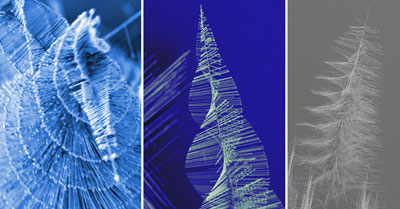博文
无种晶的纳米树
|
Dislocation-Driven Nanowire Growth and Eshelby Twist
 ,
, ,
,1 Department of Chemistry, University of Wisconsin–Madison, 1101 University Avenue, Madison, WI 53706, USA.
2 Materials Science Center, University of Wisconsin–Madison, 1509 University Avenue, Madison, WI 53706, USA.
* To whom correspondence should be addressed.
Song Jin , E-mail: jin@chem.wisc.edu
 These authors contributed equally to this work.
These authors contributed equally to this work.
Hierarchical nanostructures of lead sulfide nanowires resembling pine trees were synthesized via chemical vapor deposition. Structural characterization reveals a screw-like dislocation in the nanowire trunks with helically rotating epitaxial branch nanowires. It is suggested that the screw component of an axial dislocation provides the self-perpetuating steps to enable one-dimensional crystal growth, in contrast to mechanisms that require metal catalysts. The rotating trunks and branches are the consequence of the Eshelby twist of screw dislocations with a dislocation Burgers vector along <110> directions with an estimated magnitude of 6 ± 2 Å for the screw component. The results confirm the Eshelby theory of dislocations and the proposed nanowire growth mechanism could be general to many materials.

|
Scanning electron microscopy micrographs of lead sulfide pine tree nanowires
© Science
|
https://blog.sciencenet.cn/blog-4293-23839.html
上一篇:整理实验和文献
下一篇:关于锂电池的一点想法